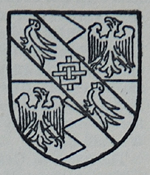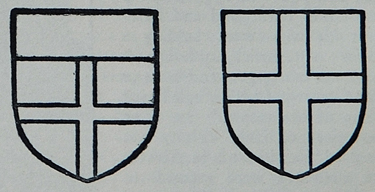A History of the County of Hertfordshire Volume 4 - Layston pages 77 to 88

 In 1217 the Prioress and nuns of Holywell claimed from Holy Trinity an eleventh part of a knight's fee in Alswick, and in 1239 the prior granted them certain lands with a mill in Alswick to hold of him and his successors.(17) These lands remained with Holywell until the 16th century,(18) when they were farmed of the convent by Holy Trinity for £5 6s. 8d.(19) The lands of Holy Trinity passed to Sir Thomas Audley after its dissolution in 1531 and he continued to farm the manor of Giberack of the nuns of Holywell until 1537, when he purchased it of the convent.(20) From this date Giberack descended with Sir Thomas's manor of Corneybury in Wyddial (21) (q.v.). It is mentioned in conveyances of that manor as late as 1811 (22)
In 1217 the Prioress and nuns of Holywell claimed from Holy Trinity an eleventh part of a knight's fee in Alswick, and in 1239 the prior granted them certain lands with a mill in Alswick to hold of him and his successors.(17) These lands remained with Holywell until the 16th century,(18) when they were farmed of the convent by Holy Trinity for £5 6s. 8d.(19) The lands of Holy Trinity passed to Sir Thomas Audley after its dissolution in 1531 and he continued to farm the manor of Giberack of the nuns of Holywell until 1537, when he purchased it of the convent.(20) From this date Giberack descended with Sir Thomas's manor of Corneybury in Wyddial (21) (q.v.). It is mentioned in conveyances of that manor as late as 1811 (22)
In the 17th century there are records of a manor called DOWNHALL in Layston. This was held by John Crouch with the manor of Alswick in 1605,(23) and it is possible that it consisted of lands held by the convent of Holy Trinity in the neighbourhood of St. Bartholomew's Church.(24) Downhall descended with the manor of Alswick,(25) the last reference to it occurring in 1720, and it is probable that after that date the two manors became merged.
In the 13th century certain lands in Alswick were held by Gilbert de Sanford, lord of the manor of Great Hormead.(26) They descended through his daughter to the Veres,(27) and in 1328 were assessed at one-third of a knight's fee.(28) No record of this as a separate holding occurs after this date and it was probably included in the manor of Great Hormead.
In the Domesday Survey several holdings are recorded in HICHINTON (Ichetone, xi cent. ; Hitchentuna, xii cent.; Ykinton, Hygenton, xiii cent.), which apparently lay within the area comprised by the later parish of Layston.(29)
In the reign of Edward the Confessor 1 hide of land in Ichetone was divided among four sokemen, one a man of Archbishop Stigand, two the men of King Edward, who paid by custom 2d., and the fourth a man of King Harold.(30) By 1086 this land had become the property of the Bishop of Bayeux and was held of him by Osbern.(31) This holding appears afterwards as a half-fee belonging to the Ports,(32) and apparently descended with the manor of Pope's Hall in Buckland (q.v.). It is lost sight of after the 14th century and was probably absorbed into the manor of Buckland, which, according to later entries, lay partly in Layston.(33) It was probably on account of this holding that Elizabeth de Burgh, lady of Pope's Hall, was able to transfer her market from New Chipping to Buntingford in 1360.
Another Saxon holding at Ichetone was the half hide of Godid, a ' man' of Asgar the Staller. After the Conquest this land came into the hands of Count Eustace of Boulogne and was held of him by Rumold,(34) the tenant of Alfladewick, and it appears with Alfladewick in the settlement made by Bernard son of Rumold (35) (see above). In the 13th century it appears with Alfladewick among the fees of the honour of Boulogne.(36) No separate record of it occurs after this time.
Twenty acres of land in Ichetone, which had been held by Godid, also came into the possession of Count Eustace, but were held of him separately by two knights.(37)
Another half hide which had been held by the Saxon Ethelmaer of Benington passed with his other lands to Peter de Valognes after the Conquest and was held of him by Humfrey.(38) This holding was probably  attached to the neighbouring manor of Stonbury, which was also held by Peter de Valognes,(39) for it cannot be traced in Layston after this date. A small holding of 3 virgates and 6 acres, which had been held by two sokemen, who paid the sheriff 3d. yearly, had passed by 1086 to Hardwin de Scales and was held of him by Theobald.(40) It was probably part of the Scales' holding in Throcking, of which Theobald was also tenant in 1086,(41) for at the beginning of the 15th century Geoffrey de Bermingham was holding land in Ichington near Buntingford of the manor of Throcking.(42) Six acres of land also in Ichetone were held under Edward the Confessor by Aldred, one of his thegns, and after the Conquest passed to Eudo Fitz Hubert and were held of him by Walter.(43) These small holdings probably were absorbed into neighbouring manors.
attached to the neighbouring manor of Stonbury, which was also held by Peter de Valognes,(39) for it cannot be traced in Layston after this date. A small holding of 3 virgates and 6 acres, which had been held by two sokemen, who paid the sheriff 3d. yearly, had passed by 1086 to Hardwin de Scales and was held of him by Theobald.(40) It was probably part of the Scales' holding in Throcking, of which Theobald was also tenant in 1086,(41) for at the beginning of the 15th century Geoffrey de Bermingham was holding land in Ichington near Buntingford of the manor of Throcking.(42) Six acres of land also in Ichetone were held under Edward the Confessor by Aldred, one of his thegns, and after the Conquest passed to Eudo Fitz Hubert and were held of him by Walter.(43) These small holdings probably were absorbed into neighbouring manors.
In the 13th century the Knights Templars held land in Buntingford.
| 17 Dugdale, Mon. iv, 394. 18 See Feud. Aids, ii, 431 ; Valor Eccl. (Rec. Com.), i, 394. 19 Valor Eccl. loc. cit 20 L. and P. Hen. VIII, xii (2), 1027. 21 Feet of F. Herts. East. 32 Hen. VIII; Hil. 14 Geo. II; Chan.Inq. p.m. (Ser.2), clxi, 79 ; clxii, 167. 22 Feet of F. Herts. East. 51 Geo. III. 23 Chan. Inq. p.m. (Ser. 2), ccclvii, 50. 24 It is improbable that the convent would have the advowson of a church surrounded by alien territory. Its appear¬ance at such a late date suggests that it was monastic land. |
25 See references under that manor. 26 Testa de Nevill (Rec Com.), 284 Feud. Aids, ii, 431. 27 For this descent see manor of Great Hormead. 28 Cal. Inq. p.m. 1-9 Edw. III, 129, 29 See Cal. Pat. 1225-32, p. 368, from which it is apparent that Hichinton was close to Corney. In the 12th century a branch of the Hakun family lived at Hichinton and took their name from it (Rot. Cur. Reg. [Rec Com.], i, 160, 165 ; Anct. D. [P.R.O.], A 994). 30 V.C.H. Herts, i, 310b. 31 Ibid. |
32 Red Bk. of Exch. (Rolls Ser.), ii, 506 ; Testa de Nevill (Rec Com.), 270. 33 Pat. 12 Eliz. pt. ix; Chan. Inq. p.m. (Ser. 2), cclxxxiv, 96. 34 V.C.H. Herts, i, 321b. 35 Add. Chart 28344. 36 Red Bk. of Exch. (Rolls Ser.), ii, 502,576; Terns de Nevill (Rec Com.), 270,273. 37 V.C.H. Herts, i, 321b. 38 Ibid. 337b, 268. 39 Ibid. 337b. 40 Ibid. 340a 41 Ibid. 42 Chan. Inq. p.m. 12 Hen. IV no. 37. 43 Ibid. 329a. |
 | Select page number: Page 84 |  |
